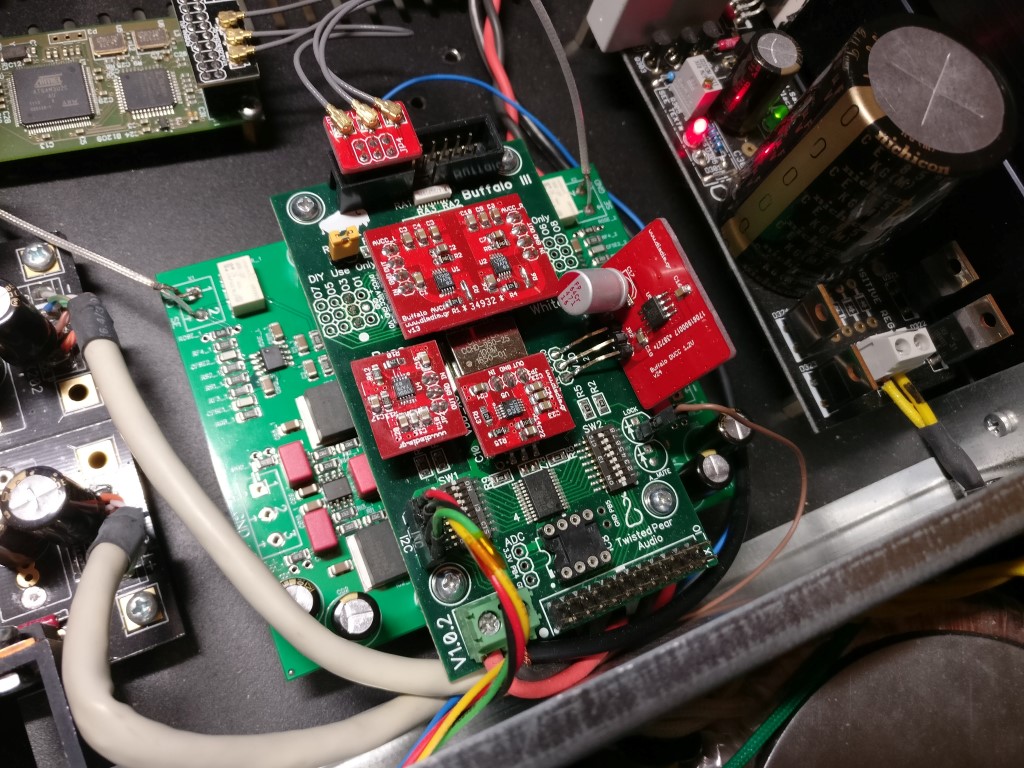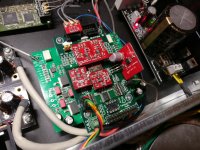I have been using Mercury with my ES9028-based DAC for a couple of days now and I must say that I'm impressed! Great job guys!
But I do have a question.. I am getting exactly 3V RMS out of the Mercury's SE outputs with the 9028 resistors installed. That is a bit on the high side, right?
I wonder if it has to do with my "mystery ES9028", sourced from Ebay, featuring no thermal pad and a chip_ID not matching either the 9028 or 9038.

But I do have a question.. I am getting exactly 3V RMS out of the Mercury's SE outputs with the 9028 resistors installed. That is a bit on the high side, right?
I wonder if it has to do with my "mystery ES9028", sourced from Ebay, featuring no thermal pad and a chip_ID not matching either the 9028 or 9038.
Attachments
Last edited:
It is really simple - just do the math - apply any ratio you wish based on your current output level.I see. So what would be a suitable set of resistors for a more "sensible" (IMHO) output level? Let's say ~2.5V RMS or even a bit less.
Last edited:
Nothing to worry over - just choose the right output level for the rest of your chain. It's all about the gain of your next stage and other practical factors.  For some applications ~2VRMs is ideal - for some 4 for some even 1.
For some applications ~2VRMs is ideal - for some 4 for some even 1.  There is no "right" answer for everyone but 2-4VRMs is common.
There is no "right" answer for everyone but 2-4VRMs is common.
DimDim...
i think Russ' estimates for Vout on the Mercury might be a little off. For me I used 120R for gain setting resistors, as Russ suggested that ought to get me close to 4 V RMS out, and I have a bit over 6 VRMS out (measured). (Mercury with 9038 Buff PRO). Not a huge difference though...
i think Russ' estimates for Vout on the Mercury might be a little off. For me I used 120R for gain setting resistors, as Russ suggested that ought to get me close to 4 V RMS out, and I have a bit over 6 VRMS out (measured). (Mercury with 9038 Buff PRO). Not a huge difference though...
My calculations are based on 50R output Z (for the 9038) keep in mind 14% lower output Z accross 120R would be about 6Vrms - where as 14% higher output Z would be just over 4Vrms.  The goal was to get you at least 4Vrms with the understanding you will have to tweak that to get an exact target output swing.
The goal was to get you at least 4Vrms with the understanding you will have to tweak that to get an exact target output swing.
thanks Russ!
No worries Russ. I just figured some folks might want to see some real world results of other gain setting. Ii will probably leave it as is as the difference between 4 VRMS and 6 VRMS is no big deal anyway.
My calculations are based on 50R output Z (for the 9038) keep in mind 14% lower output Z accross 120R would be about 6Vrms - where as 14% higher output Z would be just over 4Vrms.The goal was to get you at least 4Vrms with the understanding you will have to tweak that to get an exact target output swing.
No worries Russ. I just figured some folks might want to see some real world results of other gain setting. Ii will probably leave it as is as the difference between 4 VRMS and 6 VRMS is no big deal anyway.
For ES9038 - If one is optimistic that their DAC is operating to nominal output Z they would use 50R to get just over 2VRMs (and multiples to go higher) - if one want to ensure "at least 2Vrms" they need around 58-60R (or multiples) and then they can trim down very simply.  For ES9028 just multiply R by 4
For ES9028 just multiply R by 4  That's why I suggested 120R for you. In the end - you have all of the data to pick your own value - or to adjust based on the actual output impedance of your DAC. The other option is to use the auto-trimming feature of this DAC at the cost of dynamic range.
That's why I suggested 120R for you. In the end - you have all of the data to pick your own value - or to adjust based on the actual output impedance of your DAC. The other option is to use the auto-trimming feature of this DAC at the cost of dynamic range.
Last edited:
I am going to go to 90 ohms (9038). that should get me right about where I'd like to be so I do not have to use all that much attenuation even for the highest average level recordings.
BTW, what are the typical DC offsets expected with Mercury? I am seeing just under 2 mV differential at the balanced outputs (that is with gain resulting in ~6.2 V out at 0 dB).
BTW, what are the typical DC offsets expected with Mercury? I am seeing just under 2 mV differential at the balanced outputs (that is with gain resulting in ~6.2 V out at 0 dB).
Absolute offset is a function of the part tolerances/offset of the opa1632s and the resistors  But it should always be very low as you are seeing (mine measures < 1mv about 200uV) - as as long as you use .1% resistors you will get offset so low as to enable DC coupling to just about anything.
But it should always be very low as you are seeing (mine measures < 1mv about 200uV) - as as long as you use .1% resistors you will get offset so low as to enable DC coupling to just about anything.
You can look at the datasheets for offset info.
Also keep in mind - many instruments have some degree of error and limits on accuracy. My DMM for instance always reads higher than my bench meter and my oscilloscope or PC measurements.
You can look at the datasheets for offset info.
Also keep in mind - many instruments have some degree of error and limits on accuracy. My DMM for instance always reads higher than my bench meter and my oscilloscope or PC measurements.
Thanks Russ, yep .1% resistors here, and 1.8mV-1.6 mV offset. Interestingly it does not change much (if at all) with warm up. I did not bother matching the "best" resistor pairs per channel and will do this when I get my 90R parts in.
No problems, just a small soft pop when bringing the amp online, but probably not enough offset to care about.
No problems, just a small soft pop when bringing the amp online, but probably not enough offset to care about.
Gain update...
Further data point on my Mercury. Now running 90R resistors, I am getting 4.6 out.
Russ, one question, what would be the current output capability of this circuit (just curious) would it be based on the buffer chip capability, or the OPA 1632 capability? Either way I am assuming (never a good idea, why I ask..) it is quite capable, but perhaps those who are driving various difficult amp stages might like to know...
Further data point on my Mercury. Now running 90R resistors, I am getting 4.6 out.
Russ, one question, what would be the current output capability of this circuit (just curious) would it be based on the buffer chip capability, or the OPA 1632 capability? Either way I am assuming (never a good idea, why I ask..) it is quite capable, but perhaps those who are driving various difficult amp stages might like to know...
Russ, one question, what would be the current output capability of this circuit (just curious) would it be based on the buffer chip capability, or the OPA 1632 capability?
The balanced outputs are ultimately driven by the OPA1632s.
I was checking my B3 with I/V upgraded to Mercury. Consider following as a measurement of Audioprobe Spartan A card using B3, because I believe the DAC performs much better. Russ, doesn't it? :-D
Index of /pub/Twisted_Pear_Audio_Buffalo_III_DAC_with_Mercury
Index of /pub/Twisted_Pear_Audio_Buffalo_III_DAC_with_Mercury
Thanks Miero!
Wow! That confirms my suspicions that this is my best I/V stage yet!
Subjectively I have always loved it - but I am so glad to see those excellent measurements.
I would love to see those measurements with the ES9028/38 as well! The ES9018 is no slouch though!
Cheers!
Russ
Wow! That confirms my suspicions that this is my best I/V stage yet!
Subjectively I have always loved it - but I am so glad to see those excellent measurements.
I would love to see those measurements with the ES9028/38 as well! The ES9018 is no slouch though!
Cheers!
Russ
- Home
- More Vendors...
- Twisted Pear
- Introducing Mercury - Achieving escape velocity.
